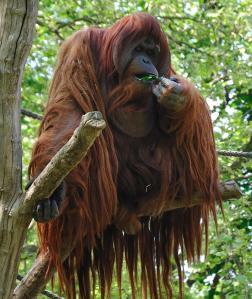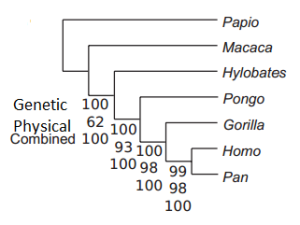This week we have another excellent question (abridged slightly) from Art, who asks….
In 1987, as you probably know, Schwartz published THE RED APE, in which he argued that morphologically humans are a great deal more similar to orang utans than to any other great ape; so that the closest living relatives of humans are not chimps but orang utans.
….
What’s going on? Is he largely unknown? Are his statements about morphology provably wrong, or perhaps embarrassingly right, or what?
This is a very important question that would fundamentally change our view of human evolution. It would also have profound implications for the evolutionary significance of DNA similarity, given that (as you’re all probably aware) chimps and more genetically similar to humans than any other animal. If Schwartz has a point then this casts doubt on the entire field of phylogenetics as well as the accepted view of human evolution. But does he?

An orang-utan demonstrating their ability to grow long hair
Schwartz and his arguments are far from unknown and he does appear to have identified many ways in which humans are more similar to orang-utans than chimps. We both can grow long hair, have long pregnancies and much more. All in all he identified around 30 ways in which we are more similar to the red apes than to the African ones. But the question remains whether these are significant similarities. After all, there are more than 30 physical characteristics traits.
So in 2009 Schwartz collaborated with another researcher called John Grehan to test whether the similarity between humans and orang-utans held up when more features were examined. The resulting paper, called Evolution of the second orangutan: phylogeny and biogeography of hominid origins, examined 70 or so traits overall. They detected around 30 traits that were similarities between humans and orang-utans, but not chimps; and only found only 7 unique similarities between chimps and humans.
Looking for these unique similarities is critical because they provide evidence of common ancestry. If species A shares a lot of traits with species B but not species C then the odds are A and B are more closely related. Conversely traits shared by all 3 species don’t really tell us who is more related to whom. Such unique traits are called “synapomorphies” and are generally used to define groups of closely related species. Pay attention, because I’ll be calling them that from now on to save me from re-typing “unique similarities” a bunch of times (a phrase which makes no sense anyway).
So, it seemed that there was finally evidence that Schwartz was onto something; so other scientists began to get in on the action. Another team of researchers expanded the characteristics examined by Grehan and Schwartz to over 300 and re-did the analysis. Except this larger data set indicated that humans and chimps share the most synapomorphies; concluding with 98% confidence that they’re our closest living relatives after all.

The family tree produced by the critics of Schwartz and Grehan. The numbers represent the % support different datasets support each branch. Pongo = orang, Homo= humans, Pan = chimps
Grehan and Schwartz didn’t take this lying down however, and criticised the method used by this other team of researchers. They felt that there were problems with many of the new traits, and so cut them from the analysis. They also excluded any traits unique to one species (known as autapomorphies), shared by all the apes or shared with Baboons (who were used as an outgroup in the study). This left them with 239 traits, which they re-examined and once again concluded that humans are more closely related to orang-utans.
However, playing around with autapomorphies and outgroups isn’t done at the start of a traditional phylogenetic analysis. This stops any a priori assumptions about the data from influencing what traits are used in the study. It is done at the start of Hennigian phylogenetics; but when Schwartz and Grehan did their actual analysis they didn’t use a Hennigian method, reverting back to the traditional approach instead. This mixing and matching of methods is generally considered poor form, so the researchers who criticised the original paper don’t believe Grehan and Schwartz’s followup is a major challenge to their conclusion. And I’m inclined to agree with them (although I known next to nothing about phylogenetic methodology).
Schwartz is still a renowned expert in orang-utans whose research has made many important contributions to our understanding of human evolution. The growing body of evidence that the last common ancestor of chimps and humans was more orang-like than chimp-like is partly based on his work, for example. But it would seem his conclusions about the relationships don’t hold water, unless you’re looking at a limited sample of traits or using a funky methodology; neither of which are advised.

